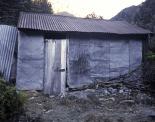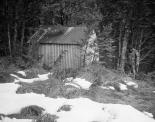HISTORIC HUTS Gallery
DEATH VALLEY HUT (now called Kay Creek Hut) has had an interesting history and involved quite a few locals with it’s various reincarnations. For those of you who don’t know, it is situated on the true right of Kay Creek just above where Death Valley Creek joins. The land was originally part of Run No. 419, Routeburn Station first farmed by John Trotter Butement as part of his huge estate at the Head of Lake Wakatipu.
Wattie Watson bought Routeburn in 1954 from Lewis Groves who was the father of his wife Betty and also of Reta Thomson of Earnslaw Station. Elaine, Ronda, Sharyn, Meryn and Alister all grew up there when life was much more isolated because the Dart Bridge wasn’t completed until 1974 and access was usually via Kinloch and TSS Earnslaw or by horse over the river.
Sheep were grazed in Scott’s Basin and beyond until relatively recently and there was an existing, albeit run-down hut at Death Valley when Wattie took over. There was also another hut in Scott’s Basin itself just on the edge of the bush on the true left of the creek. Both were an important part of farming operations when mustering sheep off the hill. However the tumbledown condition of Death Valley Hut encouraged Wattie to rebuild and he, Dick Watson and Bill and Angus Jenkins set out to erect the framework in the autumn of 1960. Dick recalls the site being very open in those days because of the grazing pressure from large mobs of deer. He also recalls being sent into the dark, freezing bush to chop beech saplings while Wattie trimmed them to size out in the sunshine. Dick doesn’t feature in the photos because he was taking advantage of the opportunity to use Wattie’s new camera. The photo shows how the beech poles were erected to form a framework which was completed on the first trip.
After the winter they returned to finish the project. They were able to recycle the flat iron from the old structure to clad the walls but they still needed iron for the roof and malthoid for lining. This was before the era of helicopters and so the necessary supplies were flown in by Tex Smith in his Cessna and dropped from the wings…..with no breakages. The completed hut had four sacking bunks and a fireplace so quite adequate for the needs of the farm.
Two of the stories to do with the area involve snow raking. In ‘Open Country Muster’ by Jim Henderson there is an epic tale by Walter Clingin of snowraking 1500 halfbred sheep from the area in harsh conditions over ten days spent at Scott’s Basin Hut. He describes what’s involved with snow raking;
“With the snow so deep it’s quite impossible for the sheep to walk over it, so what you do when snowraking is to tramp up and down endlessly, hour after hour, laboriously tramping a track in the snow firm enough and wide enough for the sheep to walk along. This track would be two feet wide and the snow on either side of it two feet deep. The sheep would quickly size up what was wanted and start on the way down to safety.”
He also describes what a welcome sight Scott’s Valley Hut was when he arrived absolutely frozen having been caught in a blizzard and fallen through the snow cover and into the creek below. “Huntly (Groves) wrapped all the blankets he had around me and then started heating stones to put in the bed to warm me up. I thought I’d never get warm again.”
Mark Hasselman (Huss) had reason to be grateful for the same hut many years later when he was working for Russell and Trish Hamiltonin the mid 70’s. A few sheep had been spotted high in Death Valley stuck in two feet of snow and Dave Saxton offered to fly Huss up there in his Hughes 300 with his heading dog Pete, a set of blades and a woolpack to shear the sheep so the fleeces wouldn’t be lost. It was a windy day and Huss recalls having to go over the Double Barrel Saddle to get into Death Valley. The sheep were confined by the snow so it was an easy job to grab the first sheep and shear it. But by the time it came to get the second sheep, the others had scattered further into the drifts and Huss was beginning to wonder about the logistics and sanity of the whole exercise. He realised that he wouldn’t be able to get over Death Valley saddle into Scott’s Creek so the only option was to head downstream to Death Valley Hut. There was still some daylight remaining so he headed up Kay Creek, over Kay Creek saddle and arrived at Scotts Basin Hut after dark. It was a long cold night snuggled up to Pete and Russell and Trish were very pleased to see him when he finally arrived back at Routeburn next morning.
Russell Hamilton, Guy Bellerby and Huss did the last muster of Scott’s Basin, spending a night in Death Valley Hut where they gathered up sheep from the back basins of Mt Bonpland and Death Valley, before mustering Scott’s Basin itself. After Ngai Tahu took over Routeburn Station the high altitude country was retired from grazing.
Only occasional trampers and hunters visited Death Valley Hut and it again fell into a state of disrepair. This all changed in 2016 when Otago University School of Physical Education took over responsibility for the hut and restored it. You can read about this in the following Otago Daily Times article where you will probably spot Tussock (Paul) Chapman in the photo.
Scott’s Basin Hut was in a poor state of repair when it was removed by DOC in the early ‘90’s.
Photos supplied bu Elaine Kirkland and Geoff Spearpoint.



